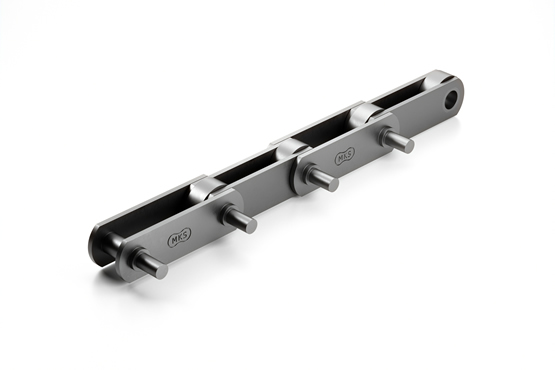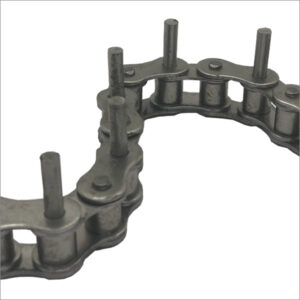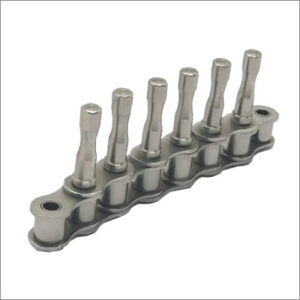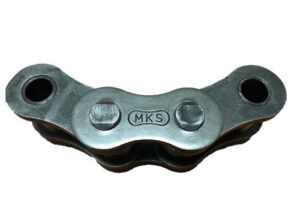
As Makelsan Chain, we mount the pins on the chains at the desired intervals on chains with extended pins that we specially design according to the demands and needs of our customers.
Generally, reciprocating extended pin chains are used by attaching a shaft, pipe or bucket to the pins. The attached shaft or pipes make a rotational movement on the pin and displace the part on it. It is also used for vertical transport as an elevator system in multi-storey machines with buckets mounted on pins.
Our chains with extended pins , which we produce as carbon steel, stainless steel or coated according to the needs, are used as chains that provide the transmission of the product as a parallel chain system in light load conveyor, packaging, packaging and similar sectors.
The main advantage of this type of conveyor chain is that the power is applied without torque at the center of the chain.
What are Extended Pins Chains?
Extended Pin Chains are special chains designed for load handling, conveyor systems and various industrial applications. The main feature of these chains is the output pins, which are placed at regular intervals along the chain and allow elements such as shafts, pipes or buckets to be mounted on them. This structure allows the parts mounted on the chain to rotate and thus transfer materials from one point to another.
Extended Pin Chains are frequently preferred in reciprocating systems and are generally used in areas such as light load conveyors, packaging and packaging. These chains, which can be produced with various material options (carbon steel, stainless steel, coated steel, etc.), offer customized solutions. They also offer easy assembly and disassembly thanks to their pin protrusions, ensuring a long-lasting and efficient use.
One of the advantages of these chains is that power can be transferred directly to the center of the chain without applying torque, which allows the system to operate more efficiently. Ideal for power transmission over long distances and high load carrying capacities, pin output chains also absorb shock and vibrations, reducing chain wear and extending its overall service life.
What are Extended Pins Chains Used for?
Extended Pin Chains serve as material handling and movement in a variety of industrial and mechanical applications. The unique design of these chains makes them particularly suitable for certain types of applications. Here are the main areas where extended pin chains are useful and their features:
1. Conveyor Systems:
Extended Pin Chains are used to move materials from one point to another in conveyor systems, especially in areas such as packaging, packaging, assembly lines. The pins on the chain provide additional attachment points for the materials to be transported by the conveyor.
2. Elevator and Vertical Handling Systems:
In storey machines or applications requiring vertical material handling, extended pin chains are used in systems such as bucket elevators. These chains can effectively transport materials vertically.
3. Customized Applications:
extended pin chains can be specially designed according to customer requirements. For example, placing pins at the specific distances required in a particular material handling system allows the system to operate much more efficiently.
4. High Performance and Efficiency:
The ability to apply power without torque at the center of elongated pin chains allows these chains to offer higher performance and efficiency with less wear.
5. Production Possibility in Various Materials:
These chains can be manufactured using various materials such as carbon steel, stainless steel and zinc-chrome plated. This makes them more resistant to corrosion and adapts to different working environments.
6. Increased Durability:
Extended pin chains are capable of lifting larger loads and transmitting power over longer distances. There is more space between the rollers, making the chain more resistant to shocks and vibrations.
In short, thanks to its special design and high durability, extended pin chains play a critical role in industrial handling and conveyor systems.
Extended Pins Chains Usage Areas
Roller chains with extended pins are widely used in a variety of industrial applications, including material handling equipment, conveyor systems, and other machinery that require reliable and efficient power transmission. The main benefits of these chains that will make your decision easier and more secure are that they have a high level of load-carrying capacity, they offer smooth and quiet operation, and have a longer lifespan. By carefully considering the specific requirements of the application, it is possible to select the right roller chain with an extended pin to meet the needs of your business.
Features of Extended Pins Chains
Designed with pins extending from the pitch axis for short pitch or long pitch chains, these chains are produced with excellent processing techniques, made of the best materials according to customer requirements, for bedding of special attachments, pushing or pulling operations. The pin protruding chains, which are produced in desired lengths and dimensions, can be easily installed and dismantled thanks to their protrusions. It is easier to transport and install than other chains. Pin protruding chains are specially produced, which are made of stainless steel and offer economical options with stylish designs.

In line with the conveyor needs, pins are mounted to the chain at desired intervals. This ensures that the chain operates efficiently and for a long time at high levels. These chains are produced as carbon steel, zinc-chrome plated and stainless steel.
One of the main advantages of extended pin roller chains also named as chains with attachments extended pins is their ability to handle larger loads and transmit power over longer distances. The extended pin of these chains allows for more space between the rollers, which allows the chain to absorb more shock and vibration, reducing wear and extending its overall lifespan. The larger rollers also provide more surface area for the chain to bear against, which helps to distribute the load more evenly and reduce the risk of breakage.
Extended pin roller chains are used for the transportation of functional components. The chain comes in two different versions: unilaterally and bilaterally extended duplex and triplex pins with groove insertions for locking springs, Seeger rings or E-rings and are provided with holes for splints or wire nails as safety element. Depending on the application, they can be provided with different pin diameters and special forms (grooves, etc.) allowing the transportation of various functional components
The high precision of roller chains made with extended pins also means they are able to operate in extreme environments including high temperatures and low temperatures. These conditions can cause other types of chains to become brittle or weak, but roller chains made with extended pins can withstand these environments without issue.
What to look for when selecting a roller chain with extended pins
One of the key factors to consider when selecting a roller chain with extended pins is the type of application it will be used in. For example, if the chain will be used in a conveyor system, it is important to choose a chain that is designed for this specific application. The conveyor chain is typically made from high-strength steel and features a special chain const

ruction that is designed to withstand the high loads and shock loads that are typical in conveyor systems.
Extended Pin Chain Prices
Extended pin chain prices vary depending on a number of factors. These factors include the material, size, design of the chain, the quality standards of the manufacturer and the quantity of chain ordered. Furthermore, special production requirements or additional features can further influence the price. Here are the main factors affecting the price of extended pin chains:
1. Material Type:
Different materials, such as carbon steel, stainless steel or special coatings, directly affect the cost of the chain. Stainless steel and special coatings are generally the higher cost options.
2. Chain Size and Design:
Dimensions such as the length and width of the chain and the size of the pin protrusions are important factors affecting the price. Customized designs and sizes can cost more than standard products.
3. Production Techniques:
The techniques used in the production process and the quality of workmanship also have an impact on price. High precision and quality standards can increase production costs.
4. Order Quantity:
Orders made in large quantities can lead to a reduced cost per unit. Bulk purchases are often offered by the manufacturer at more advantageous prices.
5. Manufacturer and Supplier:
The country where the chain is produced and the reputation of the supplier play an important role in pricing. Manufacturers with a high brand reputation can often charge higher prices.
6. Shipping and Logistics:
For international orders, additional costs such as shipping and customs duties may affect the total price.
For accurate information on prices and up-to-date offers, it is best to get quotes directly from the manufacturer or authorized dealers. This will not only help you find the best solution for your needs, but also allow you to choose the option that best fits your budget.
To examine the examples of the Extended Pins Chains We produce and for more detailed information please review the “MAKELSAN E-CATALOGUE”
Roller chains with extended pins, also known as pin protruding chains are specially produced, which are made of stainless steel and offer economical options with various designs. They are designed with pins extending from the pitch axis for short pitch or long pitch chains, for bedding of special attachments, pushing or pulling operations. It is also called as roller chains with attachment extended pins. Buckets and pipes can be placed on the extended pins for transportation.
The price of an extended pin chain varies depending on the length and type of pin. The material used can also be a contributing factor to how high or low the price will be.



